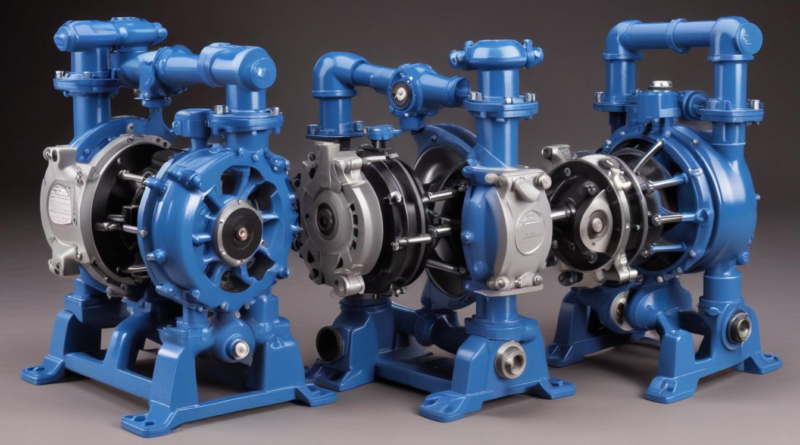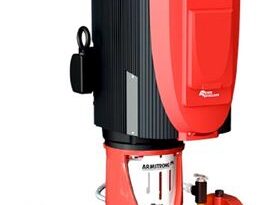types of diaphragm pumps
Single diaphragm pumps are a fundamental type of diaphragm pumps characterized by the use of a single flexible diaphragm to move fluids. This design offers simplicity and reliability, making them suitable for a variety of industrial and commercial applications. The operational mechanism involves the diaphragm being actuated by a mechanical, pneumatic, or hydraulic force, creating a reciprocating motion that draws fluid into the pump chamber and then discharges it through the outlet.
Key Features:
- Simple Design: With only one diaphragm, these pumps are easier to maintain and have fewer moving parts, reducing the likelihood of mechanical failure.
- Cost-Effective: The straightforward construction typically results in lower manufacturing and maintenance costs compared to more complex pump types.
- Versatility: Capable of handling a wide range of fluids, including corrosive and abrasive substances, without significant wear.
- Self-Priming: These pumps can self-prime, eliminating the need for external priming and enhancing operational efficiency.
Common Uses:
- Chemical Processing: Ideal for transferring and metering chemicals due to their ability to handle corrosive fluids.
- Wastewater Management: Utilized in sewage treatment plants for moving sludge and wastewater efficiently.
- Agriculture: Employed in irrigation systems and for handling fertilizers and pesticides.
- Food and Beverage Industry: Used in processing and packaging operations where contamination must be minimized.
- Pharmaceuticals: Critical for precise dosing and handling of sensitive substances.
Advantages Over Other Types:
| Feature | Single Diaphragm Pumps | Dual Diaphragm Pumps |
|---|---|---|
| Complexity | Less complex with fewer components | More complex due to additional diaphragm |
| Cost | Generally lower initial and maintenance costs | Higher costs associated with increased parts |
| Maintenance | Simpler maintenance procedures | Requires more maintenance due to complexity |
| Applications | Best for single-action pumping needs | Suitable for continuous or higher capacity applications |
The straightforward operation and robust construction of single diaphragm pumps make them a preferred choice in scenarios where reliability and ease of maintenance are paramount. Their ability to handle diverse fluids efficiently underscores their importance among the various types of diaphragm pumps available in the market today.
Dual diaphragm pumps
Dual diaphragm configurations enhance the functionality and efficiency of diaphragm pumps by incorporating two flexible diaphragms that operate either in parallel or out of phase. This design allows for continuous pumping action, reducing pulsation and increasing the overall flow rate. The synchronized movement of both diaphragms ensures a more stable and reliable performance, making them ideal for applications that require sustained and high-volume fluid transfer.
Key Features:
- Continuous Flow: Alternating diaphragms provide uninterrupted fluid movement, minimizing pulsation and ensuring a steadier output.
- Higher Capacity: Capable of handling larger volumes of fluid compared to single diaphragm systems, suitable for demanding industrial processes.
- Enhanced Durability: Redundant diaphragms reduce wear and tear on individual components, extending the pump’s operational lifespan.
- Improved Efficiency: Dual action allows for more efficient energy use, optimizing performance in various pumping scenarios.
- Versatile Operation: Can be driven by mechanical, pneumatic, or hydraulic forces, providing flexibility in different operational environments.
Common Uses:
- Industrial Manufacturing: Utilized in production lines requiring consistent and high-volume fluid handling.
- Oil and Gas Industry: Employed for the transfer of crude oil, lubricants, and other hydrocarbons with high efficiency.
- Chemical Processing: Ideal for moving corrosive and viscous chemicals, ensuring safe and reliable transfer.
- Water Treatment Plants: Used for large-scale water circulation, filtration, and treatment processes.
- Mining Operations: Applied in dewatering systems and slurry handling where robust and continuous pumping is essential.
Advantages Over Other Types:
| Feature | Single Diaphragm Pumps | Dual Diaphragm Pumps |
|---|---|---|
| Flow Rate | Lower flow rates suitable for smaller applications | Higher flow rates suitable for larger applications |
| Operational Continuity | Periodic operation with potential flow interruptions | Continuous operation with seamless fluid delivery |
| Maintenance | Simpler maintenance due to fewer components | More complex maintenance due to additional diaphragms |
| Capacity | Best for single-action pumping needs | Suitable for higher capacity and continuous applications |
The dual-diaphragm design significantly improves the performance and reliability of diaphragm pumps, making them a preferred choice for applications that demand continuous and efficient fluid handling. Their ability to manage larger volumes and maintain consistent flow highlights their importance among the various types of diaphragm pumps available in the industry today.
pneumatic diaphragm pumps
Pneumatic diaphragm pumps operate by utilizing compressed air to drive the flexible diaphragm, creating the necessary motion to transfer fluids. This method of actuation offers several advantages, particularly in environments where electrical components may pose safety risks or where intrinsic safety is required. The reliance on air pressure ensures that the pump can handle hazardous or explosive fluids without the risk of electrical ignition, making it a preferred choice in industries such as chemical processing and pharmaceuticals.
Key Features:
- Air-Driven Operation: Uses compressed air to move the diaphragm, eliminating the need for electric power sources.
- Intrinsic Safety: Suitable for use in explosive or hazardous environments where electrical equipment is restricted.
- Simple Control Mechanism: Easy to control and adjust flow rates by varying the air pressure or frequency.
- Versatile Fluid Handling: Capable of pumping a wide range of fluids, including corrosive, viscous, and abrasive materials.
- Low Maintenance: Fewer electrical components reduce the need for complex maintenance procedures.
Common Uses:
- Chemical Manufacturing: Ideal for transferring corrosive and hazardous chemicals safely.
- Pharmaceutical Industry: Utilized in the precise dosing and transfer of sensitive pharmaceutical ingredients.
- Oil and Gas: Employed in environments where explosion-proof equipment is mandatory.
- Food and Beverage: Used for hygienic pumping processes where electrical contamination must be avoided.
- Wastewater Treatment: Applied in handling sludge and other challenging wastewater components.
Advantages Over Other Types:
| Feature | Pneumatic Diaphragm Pumps | Electric Diaphragm Pumps |
|---|---|---|
| Power Source | Compressed air | Electricity |
| Safety in Hazardous Environments | Highly suitable due to lack of electrical components | Requires explosion-proof designs, increasing complexity and cost |
| Control Flexibility | Easily adjustable through air pressure and flow control | Controlled via electrical signals and motors |
| Maintenance Requirements | Lower maintenance due to fewer electrical parts | Higher maintenance needs for electrical and motor components |
| Operational Environment | Ideal for remote or mobile applications where compressed air is readily available | Best suited for stable environments with reliable electrical infrastructure |
The adoption of pneumatic diaphragm pumps is driven by their ability to operate safely in challenging environments and handle a diverse array of fluids with minimal maintenance. Their distinct advantages over electric counterparts make them an essential option among the various types of diaphragm pumps available for specialized industrial applications.
electric diaphragm pumps
 Electric diaphragm pumps are a versatile category of diaphragm pumps that utilize electric motors to actuate the diaphragms, providing precise and reliable fluid transfer. This type of pump is favored in applications where accurate control of flow rate is essential and where a stable and consistent pumping operation is required. The electric motor-driven mechanism offers enhanced efficiency and ease of integration with modern control systems, making them suitable for a wide range of industrial and commercial uses.
Electric diaphragm pumps are a versatile category of diaphragm pumps that utilize electric motors to actuate the diaphragms, providing precise and reliable fluid transfer. This type of pump is favored in applications where accurate control of flow rate is essential and where a stable and consistent pumping operation is required. The electric motor-driven mechanism offers enhanced efficiency and ease of integration with modern control systems, making them suitable for a wide range of industrial and commercial uses.
Key Features:
- Precise Flow Control: Electric motors allow for fine adjustments to the pumping speed, enabling exact regulation of flow rates.
- Energy Efficiency: Advanced motor designs reduce energy consumption, optimizing operational costs over time.
- Quiet Operation: Electric pumps generally operate with lower noise levels compared to their pneumatic counterparts.
- Compact Design: Electric diaphragm pumps are often more compact, saving space in installation environments.
- Ease of Integration: Compatible with automated systems and digital controls, facilitating seamless integration into existing processes.
Common Uses:
- Pharmaceutical Manufacturing: Used for the precise transfer of active ingredients and formulations.
- Water Treatment: Employed in the distribution and treatment processes, ensuring consistent flow rates.
- Food and Beverage Industry: Utilized in processes requiring sanitary conditions and accurate dosing.
- Chemical Processing: Suitable for handling various chemicals with precise flow control requirements.
- HVAC Systems: Applied in systems for circulating fluids efficiently and quietly.
Advantages Over Other Types:
| Feature | Electric Diaphragm Pumps | Pneumatic Diaphragm Pumps |
|---|---|---|
| Control Precision | High precision with variable speed capabilities | Less precise, dependent on air pressure fluctuations |
| Energy Consumption | Generally more energy-efficient | Higher energy consumption due to compressed air usage |
| Noise Level | Quieter operation | Louder due to air exhaust |
| Maintenance | Requires electrical maintenance, but fewer pneumatic components | Requires maintenance of pneumatic systems, air compressors |
| Installation | Requires electrical supply, often easier to install | Requires compressed air supply, may need additional infrastructure |
Electric diaphragm pumps offer significant benefits in terms of control, efficiency, and integration capabilities, making them an essential option among the various types of diaphragm pumps available for modern industrial applications.
materials and construction
The materials and construction of diaphragm pumps are critical factors that determine their suitability for various applications, impacting their durability, chemical resistance, and overall performance. These pumps are engineered using a combination of materials selected to withstand the specific demands of the fluids they handle and the environments in which they operate.
Key Materials Used:
- Diaphragms: Typically made from elastomers such as Viton, Nitrile, EPDM, or PTFE. The choice of material depends on the chemical compatibility and temperature resistance required for the application. For instance, PTFE diaphragms are preferred for highly corrosive fluids due to their excellent chemical resistance.
- Pump Bodies: Constructed from materials like stainless steel, cast iron, brass, or plastic composites. Stainless steel is favored in sanitary applications, such as the food and pharmaceutical industries, because of its hygienic properties and resistance to corrosion.
- Seals and O-Rings: Manufactured from materials such as EPDM, NBR, or Silicone to ensure effective sealing and prevent leaks. The selection is based on the type of fluid being pumped and the operating temperature range.
- Pistons and Valves: Often made from hardened metals or durable plastics to withstand wear and tear, especially in abrasive or high-pressure environments.
Construction Features:
- Modular Design: Many diaphragm pumps feature a modular construction, allowing for easy maintenance and the replacement of individual components without disassembling the entire pump. This design enhances the pump’s longevity and reduces downtime.
- Corrosion Resistance: Components exposed to corrosive fluids are often coated or made from inherently resistant materials to prevent degradation and extend the pump’s service life.
- Compact Assembly: Diaphragm pumps are typically designed to be compact, facilitating installation in space-constrained environments while maintaining high performance.
- Sealed Systems: To prevent contamination and ensure the integrity of the fluid being pumped, many diaphragm pumps incorporate sealed systems that eliminate direct contact between the fluid and external environment.
Material Selection Considerations:
| Factor | Description | Impact on Material Choice |
|---|---|---|
| Chemical Compatibility | The ability of pump materials to resist degradation by the fluid being handled. | Selection of diaphragms and seals based on the specific chemicals to prevent corrosion and contamination. |
| Temperature Range | The operational temperature extremes the pump must endure. | Use of materials like PTFE for high temperatures or EPDM for moderate temperatures to maintain flexibility and integrity. |
| Pressure Requirements | The level of pressure the pump must operate under. | Choosing robust materials like stainless steel or hardened plastics to withstand high pressures without failure. |
| Wear Resistance | Exposure to abrasive or particulate-laden fluids. | Incorporation of abrasion-resistant materials in diaphragms and valves to reduce wear and extend pump life. |
| Cost Constraints | Budget limitations for both initial purchase and ongoing maintenance. | Balancing material quality with cost-efficiency, opting for cost-effective alternatives where appropriate without compromising performance. |
The thoughtful selection of materials and meticulous construction techniques ensure that diaphragm pumps can meet the rigorous demands of diverse industries. By tailoring the pump’s materials to the specific uses and environmental conditions, manufacturers can enhance performance, reliability, and longevity, making diaphragm pumps a versatile choice among the various types available in the market.




